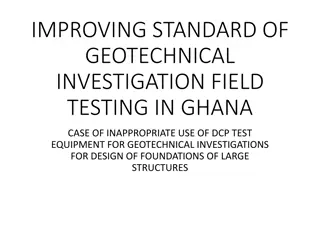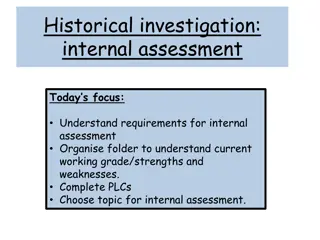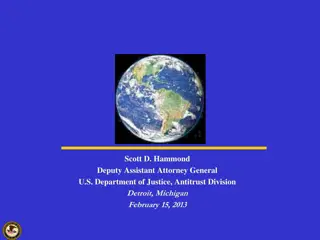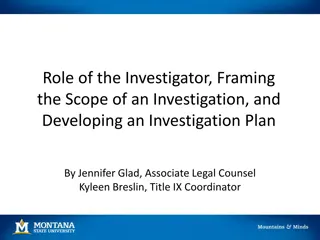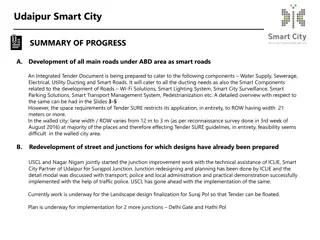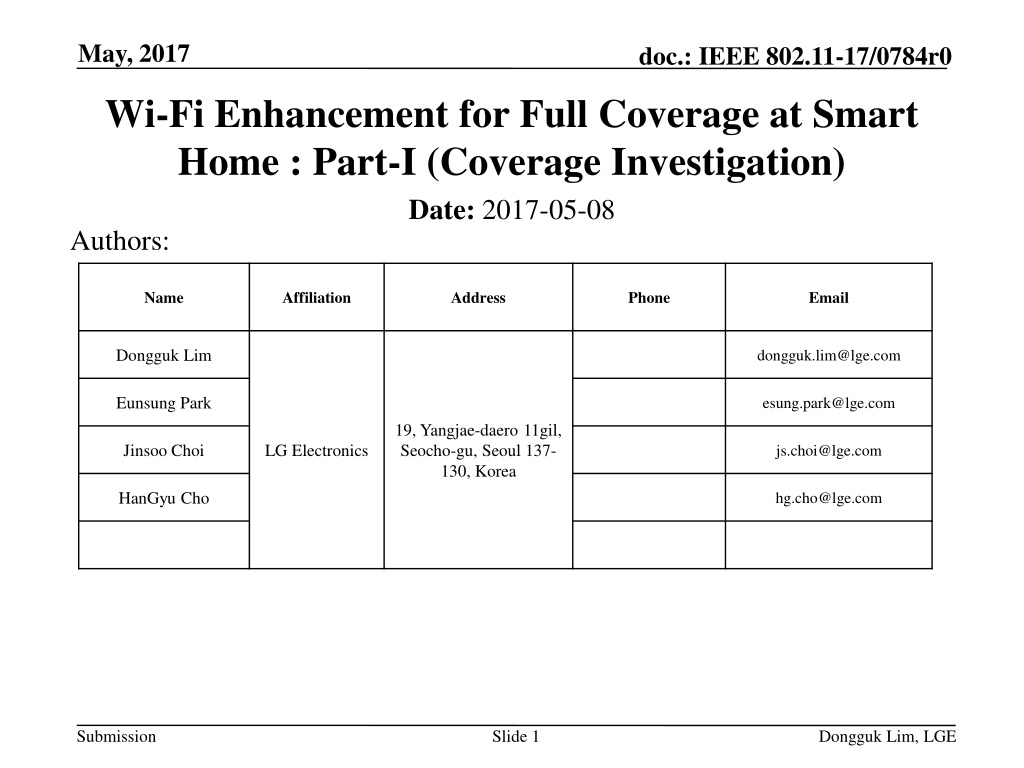
IEEE 802.11-17/0784r0 Wi-Fi Enhancement for Full Coverage at Smart Home: Part-I
This presentation explores the coverage issues of current IEEE 802.11 wireless LAN in smart homes, emphasizing the need for full coverage. It introduces narrow-band transmission to enhance signal-to-noise ratio (SNR) for improved coverage. The analysis assumes a Wi-Fi system operating on 2.4GHz or 5GHz bands and investigates performance in a realistic home environment with specified assumptions regarding topology and OBSS interference.
Download Presentation

Please find below an Image/Link to download the presentation.
The content on the website is provided AS IS for your information and personal use only. It may not be sold, licensed, or shared on other websites without obtaining consent from the author. Download presentation by click this link. If you encounter any issues during the download, it is possible that the publisher has removed the file from their server.
E N D
Presentation Transcript
May, 2017 doc.: IEEE 802.11-17/0784r0 Wi-Fi Enhancement for Full Coverage at Smart Home : Part-I (Coverage Investigation) Date: 2017-05-08 Authors: Name Affiliation Address Phone Email Dongguk Lim dongguk.lim@lge.com Eunsung Park esung.park@lge.com 19, Yangjae-daero 11gil, Seocho-gu, Seoul 137- 130, Korea Jinsoo Choi LG Electronics js.choi@lge.com HanGyu Cho hg.cho@lge.com Submission Slide 1 Dongguk Lim, LGE
May, 2017 doc.: IEEE 802.11-17/0784r0 Abstract This presentation : investigates coverage issue of current IEEE 802.11 wirelessLAN when the WLAN is used for Smart home, introduces the Narrow band transmission to improve the SNR and to support the full coverage of home. Submission Slide 2 Dongguk Lim, LGE
May, 2017 doc.: IEEE 802.11-17/0784r0 Introduction The Wi-Fi has been used as a key connectivity technology at home. And, the usage of Wi-Fi for home appliance has been increasing year by year. E.g. LG Electronics announced to use Wi-Fi in all of home appliances in 2017. So, it is required for Wi-Fi to support various devices and services at home. E.g. streaming, audio and smart home services described in appendix. But, it is hard to secure link connection and quality everywhere at home. If device is far from the AP and/or many obstacles like wall or floor are located between AP and the device, the received signal is very poor. => We need to investigate that the current Wi-Fi can support various devices and services everywhere at home OBSS interference from neighbor house Submission Slide 3 Dongguk Lim, LGE
May, 2017 doc.: IEEE 802.11-17/0784r0 Assumption for analysis (1/2) : Topology To investigate the raised issue of home Wi-Fi, we assume the WLAN system which operates on 2.4GHz band or 5GHz band for our analysis. The 11ax system which has been designed for dense environment including the residential use case is assumed. And, to confirm the impact of the frequency characteristic, both 2.4GHz and 5GHz band are assumed for investigation. We investigate the performance of the WLAN system in realistic home environment where we use the modified scenario from the simulation scenario-1[1]for the simulation. One Apartment is constructed with four rooms Single AP, Single STA per room 1. Number of wall traversed for each STA One wall : STA 1, STA2 Two wall : STA3 5m AP STA1 2. Distance of each STA STA1 : 7m STA2&STA3 : 10m 10m STA3 STA2 Submission Slide 4 Dongguk Lim, LGE
May, 2017 doc.: IEEE 802.11-17/0784r0 Assumption for analysis (2/2) : OBSS interference For the consideration of the influence of interference in home, the following interference measurement is assumed. To measure the interference, we considered the RSSI of OBSS PPDU in residential environment as provided in [2]. RSSI of detected OBSS PPDU ( 80MHz ) In the downlink, we can observe that the 10% of STAs are affected by interference larger than -62dBm and the 40% of STAs are influenced by interference larger than -72dBm. => The environment used in the reference is a bit different from what we assumed in this presentation, but we simply assumed these two RSSI values as OBSS interference in our analysis. Submission Slide 5 Dongguk Lim, LGE
May, 2017 doc.: IEEE 802.11-17/0784r0 Required SNR per MCS for analysis FER Performance at 10% FER on 20MHz Based on the frame formats which are defined in 11ax, we check the performance and further consider the beamforming case in the simulation. Required SNR of each MCS level at 10% FER (dB) Simulation assumption is in Appendix 2) 2.4GHz band 1) 5GHz band MCS level SNR1) (dB) SNR2) (dB) SNR3) (dB) MCS level SNR1) (dB) SNR2) (dB) SNR3) (dB) 0 8 3.3 0.8 0 8.5 4.4 1.9 1 11 6.2 2.3 1 11.2 6.9 4 2 15.8 10 3.5 2 15.1 10.5 5.7 3 16.6 11.5 5.6 3 16.7 12.1 9.5 4 21.6 16 8.4 4 21.1 16.5 11.9 5 24.5 19.5 12.6 5 25 20.3 13.7 6 26.6 21.3 14.2 6 27.3 22 15.6 7 28.8 23.6 15.5 7 29.1 24.1 17.2 8 31.4 26.8 20 8 33.8 28.1 21.6 9 33.8 28.6 21.8 9 36 29.5 23.6 1) SU PPDU, 2) Extended Range PPDU w/ 106-tone RU, 3) SU-PPDU w/ 3x2 beamfomring Submission Slide 6 Dongguk Lim, LGE
May, 2017 doc.: IEEE 802.11-17/0784r0 Received SINR per distance for analysis (1/2) We used the Link budget described in appendix to find out how much SINR the STA can get according to environment in home. In 5GHz band TGnD indoor channel,5GHz, Tx power = 21dBm, wall = 1 TGnD indoor channel,5GHz, Tx power = 21dBm, wall = 2 70 70 interference = -62dBm interference = -72dBm interference = -62dBm interference = -72dBm 60 60 50 50 40 40 30 30 SINR SINR 20 20 10 10 0 0 -10 -10 -20 -20 -30 -30 0 2 4 6 8 10 12 14 16 18 20 0 2 4 6 8 10 12 14 16 18 20 Distance Distance Received SINR according to Distance Received SINR according to Distance Distance from AP / Interference Distance from AP / Interference -72 dBm -62 dBm -72 dBm -62 dBm 7m 16.45 6.478 7m 5.454 -4.522 10m 0.032 -9.943 10m 11.03 1.057 Submission Slide 7 Dongguk Lim, LGE
May, 2017 doc.: IEEE 802.11-17/0784r0 Received SINR per distance for analysis (2/2) In 2.4GHz band TGnD indoor channel,2.4GHz, Tx power = 20dBm, wall = 1 TGnD indoor channel,2.4GHz, Tx power = 20dBm, wall = 2 70 70 interference = -62dBm interference = -72dBm interference = -62dBm interference = -72dBm 60 60 50 50 40 40 30 30 SINR SINR 20 20 10 10 0 0 -10 -10 -20 -20 -30 -30 0 2 4 6 8 10 12 14 16 18 20 0 2 4 6 8 10 12 14 16 18 20 Distance Distance Received SINR according to Distance Received SINR according to Distance Interference /Distance from AP Interference /Distance from AP -72 dBm -62 dBm -72 dBm -62 dBm 7m 10.69 0.8388 7m 21.69 11.84 10m 5.268 -4.583 10m 16.26 6.417 Submission Slide 8 Dongguk Lim, LGE
May, 2017 doc.: IEEE 802.11-17/0784r0 Analysis: Required additional SNR (1/5) Comparing received SINR with required SNR at 10% FER of MCS0 Based on the received SINR of previous slides, we check how much SNR improvement is required for Wi-Fi transmission depending on STA s condition. 5GHz band STA w/ -62dBm interference Required additional SNR = required SNR at 10% FER of MCS0 received SINR STA1 (7m, w/ 1wall) STA2 (10m, w/ 1wall) STA3 (10m, w/ 2wall) 6.478 1.057 -9.943 Received SINR (dB) 1.5 7 18 SU PPDU Required additional SNR (dB) 2.2 13.2 ER w/ 106 0 10.7 3x2 BF 0 0 As shown in results, it is difficult to support the full coverage without enhancement of SNR and even though the transmit scheme such as beamforming (e.g. 3x2 BF) is used for transmission, the SNR larger than 10dB is required in worst case (18dB is required with the SU PPDU) Submission Slide 9 Dongguk Lim, LGE
May, 2017 doc.: IEEE 802.11-17/0784r0 Analysis: Required additional SNR (2/5) 2.4GHz band STA w/ -62dBm interference STA1 (7m, w/ 1wall) STA2 (10m, w/ 1wall) STA3 (10m, w/ 2wall) 11.84 6.417 -4.583 Received SINR (dB) 2.1 13 SU PPDU 0 Required additional SNR (dB) 9 ER w/ 106 0 0 6.5 3x2 BF 0 0 We observed that even though the 2.4GHz band which has better frequency characteristic is used for transmission, SNR improvement larger than 13dB is required by using the SU PPDU in the worst case (6.5dB is still needed with 3x2 BF) Submission Slide 10 Dongguk Lim, LGE
May, 2017 doc.: IEEE 802.11-17/0784r0 Analysis: Required additional SNR (3/5) In the previous slides, we showed that significant SNR improvement is required to cover the STA that is under the worst condition at home. On the other side, we investigate how much SNR improvement is needed to support various home services. As shown in appendix, according to type of home service, the required data rate (~500Mbps) is very different. For the analysis, we assume the multimedia service such as streaming video. For example, if we want to watch a streaming video by using YouTube (e.g. resolution is 720p), then the required data rate can be calculated as following Data rate = (1280 * 720) (resolution) * 30(fps) * 0.27(compression) * (100/70) (MAC efficiency) / 1024 / 1024 = 10.1702Mbps Here, we assume the mac efficiency as 70% In next slides, we calculate the required additional SNR to support the data rate addressed above. Submission Slide 11 Dongguk Lim, LGE
May, 2017 doc.: IEEE 802.11-17/0784r0 Analysis: Required additional SNR (4/5) Required additional SNR (according to MCS level to satisfy the data rate of service, e.g. streaming video) STA w/ -62dBm interference (5GHz band) The least MCS which can support the target data rate was selected from 11ax MCS table STA1 (7m, w/ 1wall) STA2 (10m, w/ 1wall) STA3 (10m, w/ 2wall) 1.057 -9.943 6.478 Received SNR (dB) 4.5 9.9 21 SU PPDU (MCS1)1) Required additional SNR (dB) 3.5 9 20 ER w/ 106 (MCS2)2) 1.3 12.3 3x2 BF (MCS1)1) 0 Depending on the transmission scheme, 12 ~ 21dB SNR improvement is required to satisfy the required data rate (10.17Mbps) in worst case. 1) MCS0 w/ 234 data tones: 8.1Mbps (not satisfied, so MCS1 is required), 2) MCS1 w/ 102 data tones: 7.1Mbps (not satisfied, so MCS2 is required) Submission Slide 12 Dongguk Lim, LGE
May, 2017 doc.: IEEE 802.11-17/0784r0 Analysis: Required additional SNR (5/5) STA w/ -62dBm interference (2.4GHz band) STA1 (7m, w/ 1 wall) STA2 (10m, w/ 1 wall) STA3 (10m, 2wall) 11.84 6.417 -4.583 Received SNR (dB) 4.8 15.8 SU PPDU (MCS1)1) 0 Required additional SNR (dB) 4 15 ER w/ 106 (MCS2)2) 0 8.6 3x2 BF (MCS1)1) 0 0 We can see a similar trend from 5GHz band with a bit reduced SNR requirement. 8 ~ 15dB SNR improvement is required to cover the target data rate in worst case. 1) MCS0 w/ 234 data tones: 8.1Mbps (not satisfied, so MCS1 is required), 2) MCS1 w/ 102 data tones: 7.1Mbps (not satisfied, so MCS2 is required) Submission Slide 13 Dongguk Lim, LGE
May, 2017 doc.: IEEE 802.11-17/0784r0 Discussion Based on our analysis, received SINR should be increased by 10 ~ 18dB in 5GHz and 6 ~ 13dB in 2.4GHz to cover users Wi-Fi connection in worst condition at home (e.g. w/ multiple walls, strong interference) If we further consider service requirement (e.g. data rate for streaming), we need to enhance SNR by 12 ~ 21dB in 5GHz and 8 ~ 15dB in 2.4GHz. Higher data rate required, more SNR improvement needed. So, we think it s needed to have some solution to cover Wi-Fi connection and better service requirement Submission Slide 14 Dongguk Lim, LGE
May, 2017 doc.: IEEE 802.11-17/0784r0 A possible solution : Narrow band transmission (i.e. NBT) 2.4GHz, TGnD, SNR vs Distance 100 The narrow band transmission has the following pros and cons. Pros. Due to concentration of power on narrow bandwidth, it can secure higher SNR as shown in right figure. Due to increasing of symbol length, it can also achieve robustness to the delay spread. BW = 20MHz BW = 5MHz BW = 4MHz BW = 2MHz BW = 1MHz 90 80 70 SNR 60 50 40 30 20 0 5 10 15 20 25 30 Distance Cons. The response with the sharp peak of a narrowband signal requires high-performing filters, which are precisely adjusted to avoid attenuating the active signal Due to narrow sub-carrier spacing, it might be vulnerable to carrier frequency offset. Submission Slide 15 Dongguk Lim, LGE
May, 2017 doc.: IEEE 802.11-17/0784r0 Smart Home Use Case w/ NBT Without additional equipment or system, users can access to the household appliances with Wi-Fi connectivity and get better services regardless of situation of devices Second floor user enjoys the services(e.g. streaming, audio) that require high data rate regardless of location in home First floor user manages or controls the all household appliances regardless of location in home Internet Submission Slide 16 Dongguk Lim, LGE
May, 2017 doc.: IEEE 802.11-17/0784r0 Considerations on NBT (1/2) In order to use a narrow band in UNII-band (i.e. 2.4GHz, 5GHz), firstly, we should consider the power limitation by the regulation. Band (GHz) Power Limit for AP (dBm) PSD Limit for AP (dBm/MHz) 2.4 30(1W) N/A 5.15-5.25 30(1W) 17 (50mw) 5.25-5.35 24(250mW) 11(12mW) FCC1) 5.47-5.725 24(250mW) 11(12mW) 5.725-5.85 30(1W) 30/500KHz 20(100mW) 10(10mW) 2.42) 23(200mW) 10(10mW) 5.15-5.253) ETSI 5.25-5.35 23(200mW) 10(10mW) 5.47-5.725 30(1W) 17(50mW) 30(1W) 23(200mW) 5.725-5.854) => In terms of regulation, it is expected that the Narrow band transmission on 2.4GHz (e.g. under FCC rule) is potentially able to improve the SNR. 1) 47 CFR 15.247, 2) EN 300 328 v2.1.1, 3) EN 301 893 v2.0.7, 4) 302 502 V2.0.8 Submission Slide 17 Dongguk Lim, LGE
May, 2017 doc.: IEEE 802.11-17/0784r0 Considerations on NBT (2/2) Besides power limit, in order to use the NBT on 2.4GHz or 5GHz, we should consider several issues more. DFS channel on 5GHz To avoid the false detection as radar signal, using of the NBT may be restricted. Interference in 2.4GHz Since the channels are usually congested by many devices, the NBT can be influenced by stronger interference (than what we assumed). Submission Slide 18 Dongguk Lim, LGE
May, 2017 doc.: IEEE 802.11-17/0784r0 SNR improvement by NBT We observe that as we use smaller bandwidth in 2.4GHz band (e.g. under FCC rule), we can increase the coverage that the WLAN signal can reach. E.g. when 2MHz is used for transmission w/ -62dBm interference, the received SINR can be improved by about 10dB and we can get longer coverage by about 8m. TGnD indoor channel,2.4GHz, Tx power = 20dBm, wall = 2, interference = -62dBm TGnD indoor channel,2.4GHz, Tx power = 20dBm, wall = 2, interference = -72dBm 70 70 BW = 20MHz BW = 4MHz BW = 2MHz BW = 20MHz BW = 4MHz BW = 2MHz 60 60 50 50 40 40 30 30 SINR SINR 20 20 20MHz, SNR at 10% FER 4MHz, SNR at 10% FER 2MHz, SNR at 10% FER 10 10 20MHz, SNR at 10% FER 4MHz, SNR at 10% FER 2MHz, SNR at 10% FER 0 0 -10 -10 -20 -20 -30 -30 0 5 10 15 20 25 30 0 5 10 15 20 25 30 Distance Distance Submission Slide 19 Dongguk Lim, LGE
May, 2017 doc.: IEEE 802.11-17/0784r0 Conclusion It is shown in this presentation that SNR improvement is required to support Wi-Fi connectivity and various home services everywhere at home. It is also investigated that narrow band transmission (i.e. NBT) can provide SNR improvement for this purpose. It is necessary to study issues coming from NBT, e.g. Narrow band preamble design Narrow band PHY design Legacy coexistence Submission Slide 20 Dongguk Lim, LGE
May, 2017 doc.: IEEE 802.11-17/0784r0 Reference [1] 11-14-0980-16-00ax-simulation-scenarios [2] 11-15-0551-01-00ax-obss-preamble-detection Submission Slide 21 Dongguk Lim, LGE
May, 2017 doc.: IEEE 802.11-17/0784r0 Appendix Submission Slide 22 Dongguk Lim, LGE
May, 2017 doc.: IEEE 802.11-17/0784r0 Assumption for simulation Band : 2.4GHz, 5GHz Bandwidth : 2, 4, 20MHz Channel : TGnD (indoor) CP size : 1.6us Data size : 100 Byte Ant. Conf : 1x1, 3x2 Number of Spatial Stream : 1 Impairment : CFO + TO CFO : 25PPM on 2.4GHz, 20PPM on 5GHz Channel estimation : LS+SM Submission Slide 23 Dongguk Lim, LGE
May, 2017 doc.: IEEE 802.11-17/0784r0 Link budget Transmit power Tx_Pwr = 20dBm(2.4GHz), 21dBm(5GHz) Noise figure : 7dBm Noise floor : -174dBm + 10log10BW Bandwidth : 1MHz, 2MHz, 4MHz, 5MHz, 20MHz Target PER : 10% Interference : -72dBm, -62dBm It is based on 20MHz Penetration loss Wall loss : 11dB per wall (refer the next slide) Submission Slide 24 Dongguk Lim, LGE
May, 2017 doc.: IEEE 802.11-17/0784r0 Wall loss Penetration loss as a function of frequency for two types of walls1) http://pubs.sciepub.com/wmt/1/1/6/image/tab6.png 1) P. Nobles, A comparison of indoor pathloss measurements at 2 GHz, 5 GHz, 17 GHz and 60 GHz , COST 259, TD (99)100, Leidschendam, The Netherlands, September 1999 Submission Slide 25 Dongguk Lim, LGE
May, 2017 doc.: IEEE 802.11-17/0784r0 Smart home services1) Required data rate for services 1) www.mdpi.com/journal/energies ISSN 1996-1073 Smart Home Communication Technologies and Applications: Wireless Protocol Assessment for Home Area Network Resources Submission Slide 26 Dongguk Lim, LGE
May, 2017 doc.: IEEE 802.11-17/0784r0 Link budget according to BW (1/3) 5GHz band (FCC, 5.15-5.25GHz) TGnD indoor channel,5GHz, wall = 2, interference = -72dBm TGnD indoor channel,5GHz, wall = 2, interference = -62dBm 70 70 Tx power = 30dBm, BW = 20MHz Tx power = 24dBm, BW = 5MHz Tx power = 23dBm, BW = 4MHz Tx power = 20dBm, BW = 2MHz Tx power = 17dBm, BW = 1MHz Tx power = 30dBm, BW = 20MHz Tx power = 24dBm, BW = 5MHz Tx power = 23dBm, BW = 4MHz Tx power = 20dBm, BW = 2MHz Tx power = 17dBm, BW = 1MHz 60 60 50 50 40 40 30 30 SINR SINR 20 20 10 10 0 0 -10 -10 -20 -20 -30 -30 0 2 4 6 8 10 12 14 16 18 20 0 2 4 6 8 10 12 14 16 18 20 Distance Distance All curves are overlapped by power limitation under regulation Submission Slide 27 Dongguk Lim, LGE
May, 2017 doc.: IEEE 802.11-17/0784r0 Link budget according to BW (2/3) 5GHz band (ETSI, 5.15-5.25GHz) TGnD indoor channel,5GHz, wall = 2, interference = -72dBm TGnD indoor channel,5GHz, wall = 2, interference = -62dBm 70 70 Tx power = 23dBm, BW = 20MHz Tx power = 17dBm, BW = 5MHz Tx power = 16dBm, BW = 4MHz Tx power = 13dBm, BW = 2MHz Tx power = 10dBm, BW = 1MHz Tx power = 23dBm, BW = 20MHz Tx power = 17dBm, BW = 5MHz Tx power = 16dBm, BW = 4MHz Tx power = 13dBm, BW = 2MHz Tx power = 10dBm, BW = 1MHz 60 60 50 50 40 40 30 30 SINR SINR 20 20 10 10 0 0 -10 -10 -20 -20 -30 -30 0 2 4 6 8 10 12 14 16 18 20 0 2 4 6 8 10 12 14 16 18 20 Distance Distance All curves are overlapped by power limitation under regulation Submission Slide 28 Dongguk Lim, LGE
May, 2017 doc.: IEEE 802.11-17/0784r0 Link budget according to BW (3/3) 2.4GHz band (ETSI) The Tx power is still tightly limited, so we can observe small enhancement of SNR by using NBT (about 3dB) TGnD indoor channel,2.4GHz, wall = 2, interference = -72dBm TGnD indoor channel,2.4GHz, wall = 2, interference = -62dBm 70 70 Tx power = 20dBm, BW = 20MHz Tx power = 17dBm, BW = 5MHz Tx power = 16dBm, BW = 4MHz Tx power = 13dBm, BW = 2MHz Tx power = 10dBm, BW = 1MHz Tx power = 20dBm, BW = 20MHz Tx power = 17dBm, BW = 5MHz Tx power = 16dBm, BW = 4MHz Tx power = 13dBm, BW = 2MHz Tx power = 10dBm, BW = 1MHz 60 60 50 50 40 40 30 30 SINR SINR 20 20 10 10 0 0 -10 -10 -20 -20 -30 -30 0 2 4 6 8 10 12 14 16 18 20 0 2 4 6 8 10 12 14 16 18 20 Distance Distance Submission Slide 29 Dongguk Lim, LGE




